
Ingenieurbüro für angewandte Strömungsmechanik
Contact+ About us
+ News
+ Conferences & Events
- Application Examples
- Introduction
- Automotive Industry
- Bio-medicine
- Bio-technology
- Chemical industry
- Environement
- HVAC & Safety
- Micro-fluidics + MEMS
- Power Stations
- Process simulation
- Turbo-machinery
- Vaccuum technology
- Other examples
+ Imprint
+ Terms of use
CFD for process industry
BurnersSwirl burner are often used to ensure stable and quick combustion. The turbulence models developed together with fairly detailed chemical kinetic models allow accurate predictions enabling engineers to design the burner, the catalytic converters and the heat exchangers working with the considered burner. For a copy of a paper describing cost effective turbulence models for swirl burner optimisation please contact us. |
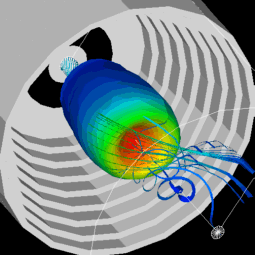 |
Centrifugal separatorsCentrifugal forces are often applied to separate dirt (particles or droplets) from a carrier medium. The question is where should the outlet be to obtain the highest purity. The first animation shows the rotation of a drum initially partially filled with liquid. The colours show the pressure distribution within the liquid. Hot colours represent a high pressure. Cold colours indicate low pressures. A separating instrument is installed within the drum which carries the purified liquid out of the separator in a direction perpendicular to the animation plane. |
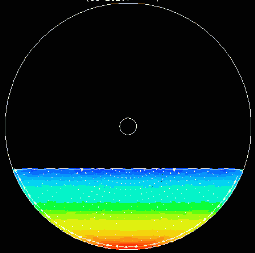 Please click for Animation (0,5 MB)
ESC to stop 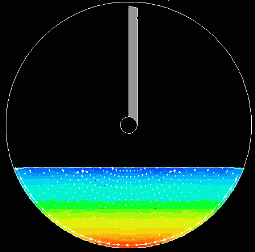 Please click for Animation (0,45 MB)
ESC to stop |
Granular flowCFD codes can predict flow conditions in multi-phase flows, provided that the disperse phase concentration is lower than 25% (vol.). The use of discrete particle methods enables the prediction of high concentration particlate flows (granular flow). This example shows the application of such methods to predict the shape of a packed bed reactor. The filling of a reactor tube is simulated. Once the tube is filled the system is vibrated to increase the packing. The comparison of the overall packed bed porosity with measurements indicates that the maximum error of the numerical scheme is below 3%. An interface has been developed by a-CFD engineers to transfer the geometrical data to suitable CFD codes. |
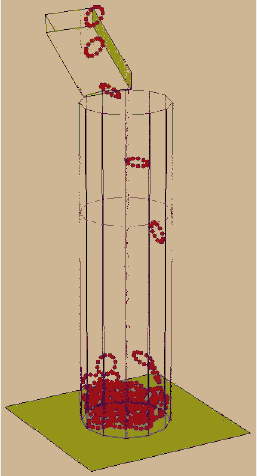 Please click for animation (5 MB)
ESC to stop |
Packed bed reactorsPacked bed reactors are usually modeled using simplified models depending on empirical information. To provide a better understanding of the flow conditions within such reactors and to provide a better optimization tool a method was devised to resolving the flow within such complex geometries. The predicted pressure drop is within 10% of measurements, and the heat transfer coefficient is within 5%. Paper: Fluent user conference, Frankental 25-26 September, 2002. more
Paper: 3rd European Congress of Chemical Engineering, Nürnberg 26-28 Juni, 2001. more
|
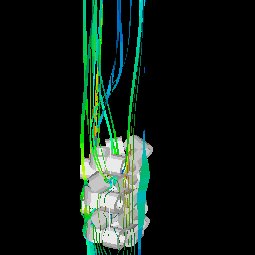 |
StirrerThis example shows the gas distribution in a stirrer where gas is let into the reactor just below the rotating blades. The gas is first accelerated outwards by the rotating flow. Along the outer wall the gas bubbles are diverted upwards and downwards. The eddies generated in the central part of the reactor carry the gas bubbles towards the center. |
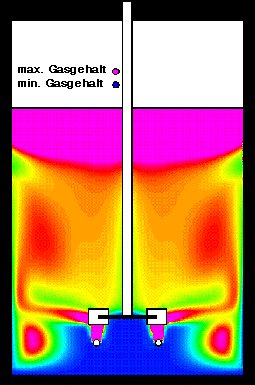 |
Swirl generatorSwirling flows are a challenge for turbulence models. More economic turbulence models are usually not capable of predicting the flow conditions in such flow regimes. Reynold's Stress models are usually recommended for such applications. However, the economic issue of industrial applications and the require response speed restrict the application of such models. In order to enable engineering predictions at reasonable costs economic turbulence models were extended to support the swirl flow conditions expected. The diagram shows the good agreement between our model and the measured axial velocity downstream from the burner nozzle. |
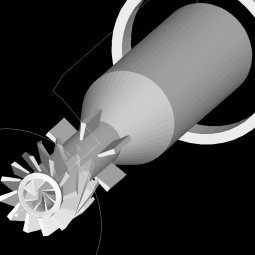 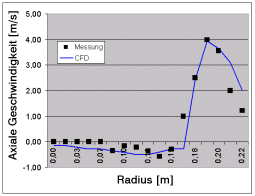 |